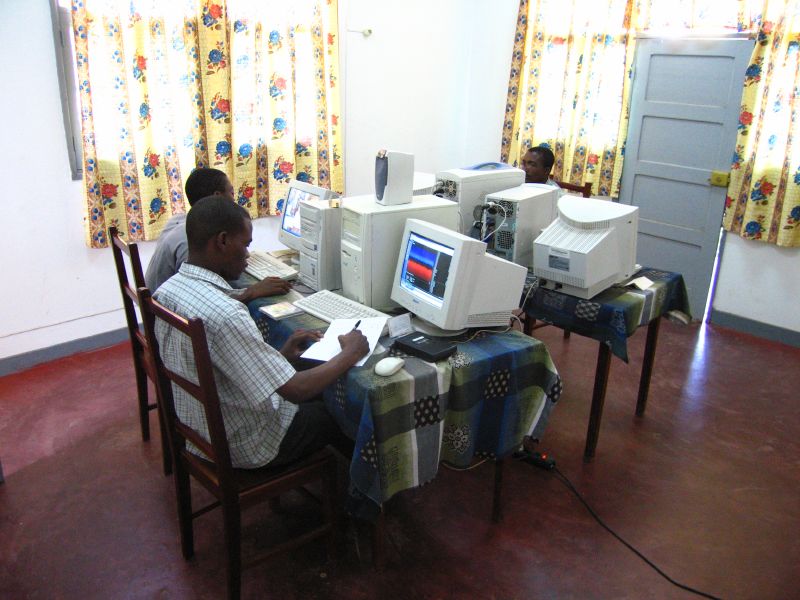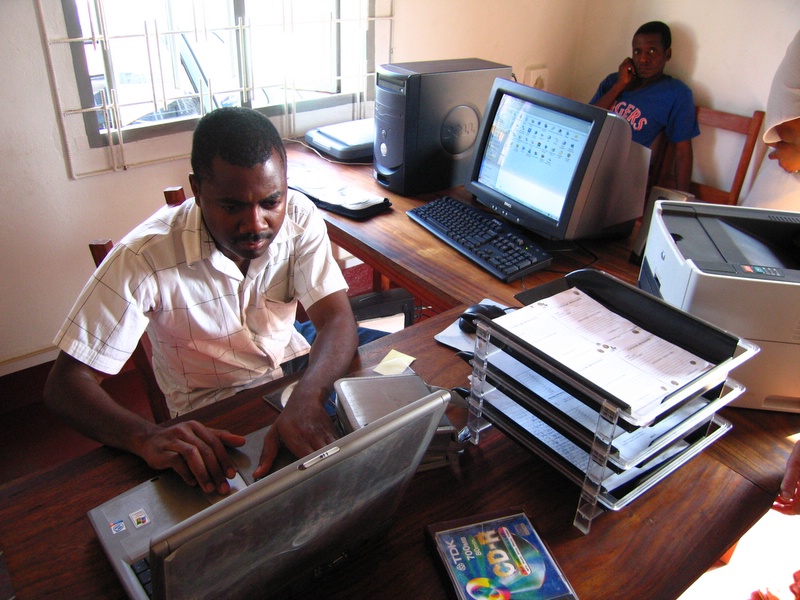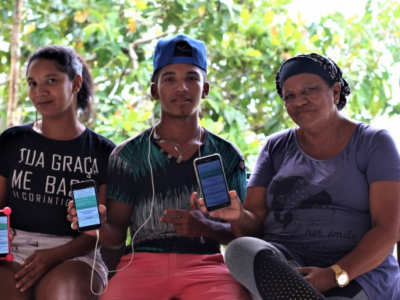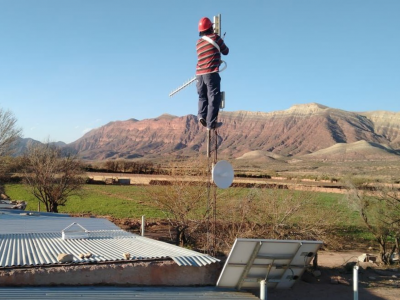The following is a three-part series that was written by Florencia Roveri of Nodo TAU and originally published on APC News and is republished here as part of a partnership between the Association for Progressive Communications and Rising Voices.
Access to the internet for local communities has been a challenge for decades for those working to achieve equal rights for all people, especially when dealing with groups that are affected, in one way or another, in terms of their access to such rights. In this respect there is a well-trodden pathway bringing together technological and community experiences in order to collaborate in the strengthening of such groups. Two milestones on this journey have been telecentres and community networks. In this article we will examine these two approaches, identified by communities as a way of obtaining access to technology.
In the decade of the 1990s, experiences emerged in numerous parts of the world that focused on extending the use of information and communication technologies (ICTs) to the entire population. These included cybercafés, telephone kiosks and telecentres. The telecentres in particular had a variety of formats and denominations such as basic telecentres, civic and multipurpose community telecentres, as well as technology centres or community telecentres.
These initiatives formed part of the boom of neoliberal policies that began to be applied in the last decade of the 20th century, deregulating the telecommunications sector in order to subject it to the rules of the market, in most cases with the marked involvement of foreign investors, who were not particularly interested in local technological development. This model of access extension, based on business reasoning, worsened the access possibilities of certain sectors. This was especially the case for people living in rural areas, geographically complex regions or on the edge of cities, deemed by companies as being expensive to connect and of low returns.
However, many governments adopted the challenge of massively extending access to the population, and developing different forms of public policies, along with strategies and varying types of relationship with the private sector and civil society. This was carried out through the creation of institutional mechanisms such as commissions, directorates, secretariats or programmes to design policies that sought to reduce the digital divide and incorporate the population into the prevailing and expanding information society. The Declaration of Florianopolis expressed and promoted this trend in the Latin American and Caribbean region in mid-2000. Telecentres arose as part of the challenge assumed by governments to provide universal access to ICTs, and respond to the imperatives of promoting development through the use and appropriation of such technologies. Policies for universal access, which require telephone companies to allocate a percentage of their profits to connecting unprofitable areas, were also part of this trend; however, even though such policies were promoted in many countries, they were not always implemented.
Community telecentres
What are telecentres and what differentiates them from other spaces that provide access to the internet?
Telecentres are public spaces to access technology set aside for a community in order to enhance its development and cohesion, providing access to equipment, connectivity and content. For the Telecentre.org Foundation, community telecentres are “places where people can use computers, the internet and other technologies and so integrate the information society on their own terms. Through the networks and organisations that work with telecentres, people who want to use technology to promote community development are empowered, whatever their development options or the place where they live.”

Chokwe community multimedia centre in Mozambique. Photo by Telecentre Foundation and used under a CC BY-NC-SA 2.0 license.
In another definition “telecentres aim to provide realistic and economic access to ICTs for people living in rural and marginalised urban areas, by concentrating services and basic telecommunications infrastructure in one place within communities,” as stated by Moisés López, who authored a thesis highlighting the experiences of telecentres around the world. López attributes the rise of telecentres to the fact that numerous organisations, “including cooperation agencies and non-governmental organisations, multilateral institutions and governments, detected the potential for social development inherent to ICTs, and the prevalent danger of a large part of the global population being denied access to these technologies.”
However, the same author warns that this impulse was carried out as a way to increase the global market and encourage international trade through the creation of new communication networks and services. “Economic motivations often overlap with social motivations when promoting ICTs in the most disadvantaged countries. But whether economic profits or the potential for social development prevail, the truth is that strategies are being designed to extend and guarantee universal access to these technologies, as a way to reduce the ‘digital divide’ from a community perspective, in order to save costs and create synergies between the different participating actors. In this sense, one of the initiatives that has awakened most expectations has been the development of telecentres,” commented the Spanish author in 2002 when writing his thesis.
Numerous analyses of telecentres have underlined the community anchorage provided by the social organisations involved. In 2006, Fernanda Di Meglio and María Soledad Oregioni analysed the role that organisations play in the construction of the information society, especially in Latin America. This basically took into account the incorporation of telecentres as a tool to fulfil this purpose, and as a complement both of the state and international organisations that devise policies for this aim. The authors stated that “although there is no definition that contemplates the different types of telecentre, the characteristic that unites them all is that of a physical space that provides public access to ICTs for development at an educational, personal, social and economic level. This is based on the premise that not all people can access ICTs. However, while access is important, appropriation of technology is fundamental.”
This research undertook a comparative study of two Latin American countries, Argentina and Peru, highlighting the Argentine experiences of Community Technology Centres, the Nodo TAU Telecentre Network, along with the experience of the Teleworking Association and the Scientific Network in Peru, a network of academic institutions created in 1991 that coordinated spaces for public access. The work also highlights the role of international organisations in the promotion and sustainability of experiences, particularly the work implemented by the Association for the Progress of Communications (APC).
At the same time, other studies have emphasised precisely the lack of community anchorage, which is one of the main criticisms of telecentres established using a top-down approach. In this sense, the main focus of the analysis is to assess whether the communities themselves participated in the setting up, maintenance and management of the telecentres or were mere users of models brought in by external agents.
In this context of internet development, with large sectors of the population without access to technology, a growing market and states in retreat, discussions have been taking place that are still pertinent today:
- How are the different actors involved in public policies coordinated?
- What are the possibilities, potentialities and limitations of social organisations in their joint actions with the state?
- What are the interests of the market and what reasoning forms part of these policies?
- And what is the role of organisations, international bodies and international financing, especially at those times when organisations occupy spaces that actually pertain to the state?
In the heart of the communities
Eduardo Rodríguez is a founding member of Nodo TAU, an APC member organisation that coordinated a network of 10 community telecentres between 2001 and 2008 in the city of Rosario, Argentina. “The essential element in terms of telecentres is the community,” said Rodríguez. The experience of Nodo TAU was developed with groups that were already organised, had experience and were known to the local population. They also had people committed to their projects, who were the ones who carried out the management and coordination of the telecentres. “The telecentre is a space in which a community shares new technologies, from the use of PCs to connection to the internet. This is a physical space where people meet face to face. The goal is to bring a certain population closer to resources that have to do with ICTs, and who would otherwise have had no such access, because no one locates a cybercafé in the parishes or community centres that we worked with. That is the meaning of the telecentres.”
Among the challenges faced by telecentres, Eduardo mentions those of a technological and community nature. “The telecentres appeared at a time of internet development in which connectivity was a huge challenge that was only resolved towards the end of that period.” And it was not only because these places were not connected to the internet: some did not even have electricity.
Among the other difficulties encountered, Eduardo also mentions coordination. “It was very difficult to maintain a person who was completely dedicated to a telecentre, and obtain the necessary resources so that such coordination was stable and sustainable. It involved a big effort and is one of the reasons why over time some of the telecentres failed. Other experiences in other countries managed to resolve this dilemma, perhaps due to conditions of greater isolation, of more exclusive resources, in more inhospitable places, in which people allocated resources for such use because there were no other options aside from the telecentre.
But the city is more complicated; there is more supply, and there are other forms of access. Today the technological aspect from the point of view of hardware has been solved. What has not been resolved is the issue of connectivity. It is either low quality or non-existent. This continues to be a critical issue in city neighbourhoods, and even more so in rural areas and in the interior of the country. Who will invest in that connectivity?” The question remains pertinent. For Rodríguez, community wireless networks contribute towards resolving that problem.
Invited to compare the model for telecentres and that of community networks, Rodríguez defines the community network as “a wireless network that requires a complex level of organisation, depending on how much progress has been made,” and highlights the novelty and potential of physically extending connectivity and taking it to critical places where access is difficult. “There are experiences in Africa, in Asia, in Latin America, where community networks provide the existing connection. There is nothing else available.”
He explained, “In the larger cities, the development of these networks is in the hands of people who are very dedicated to technology, but who sometimes find it more difficult to work at the community level. They understand the technological challenge, but sometimes when this is resolved they lose interest, and the networks are just abandoned. In the urban context it is very easy for this to happen, because you just move on a little and you have another option. There are different needs within a city compared to its periphery or a rural zone. The solution here would be to bring together those who are passionate about technological challenges with the specific needs of a community. And this could be through either working together with the community or providing it with technological training, which is what AlterMundi does in Córdoba, Argentina.”
Rodríguez also underlines his concern about the network model: “They can transform into a network of individuals, each in their place sharing the connection and its contents. There I see a big difference with telecentres. Although the network requires a community effort in terms of deployment and maintenance, afterwards it can become a form of online sharing with each individual in their own place. Moving from face-to-face sharing to online sharing is not the same. You could view this as one of the principles of capitalism: isolate the individual. And in such isolation, all of a person’s needs, entertainment and even their desires are met, but they remain isolated. To sustain the community model, networks have to redouble their efforts in all instances that involve real collaboration. From ownership of the installation and the infrastructure right down to the contents.”
In this sense, Eduardo highlights the experience of guifi.net, an APC member in Catalonia which has developed community networks. “They were able to intervene from an ideological perspective in the very heart of the network. They did not only deal with the issues of connectivity, but the right to communication and the definition of what to do with that connectivity, with what sort of content, and what idea of security.”




